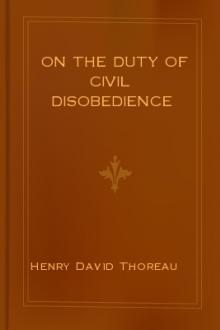Essays Henry David Thoreau (little bear else holmelund minarik .txt) 📖

- Author: Henry David Thoreau
Book online «Essays Henry David Thoreau (little bear else holmelund minarik .txt) 📖». Author Henry David Thoreau
Some single trees, wholly bright scarlet, seen against others of their kind still freshly green, or against evergreens, are more memorable than whole groves will be by-and-by. How beautiful, when a whole tree is like one great scarlet fruit full of ripe juices, every leaf, from lowest limb to topmost spire, all aglow, especially if you look toward the sun! What more remarkable object can there be in the landscape? Visible for miles, too fair to be believed. If such a phenomenon occurred but once, it would be handed down by tradition to posterity, and get into the mythology at last.
The whole tree thus ripening in advance of its fellows attains a singular preeminence, and sometimes maintains it for a week or two. I am thrilled at the sight of it, bearing aloft its scarlet standard for the regiment of green-clad foresters around, and I go half a mile out of my way to examine it. A single tree becomes thus the crowning beauty of some meadowy vale, and the expression of the whole surrounding forest is at once more spirited for it.
A small red maple has grown, perchance, far away at the head of some retired valley, a mile from any road, unobserved. It has faithfully discharged the duties of a maple there, all winter and summer, neglected none of its economies, but added to its stature in the virtue which belongs to a maple, by a steady growth for so many months, never having gone gadding abroad, and is nearer heaven than it was in the spring. It has faithfully husbanded its sap, and afforded a shelter to the wandering bird, has long since ripened its seeds and committed them to the winds, and has the satisfaction of knowing, perhaps, that a thousand little well-behaved maples are already settled in life somewhere. It deserves well of Mapledom. Its leaves have been asking it from time to time, in a whisper, “When shall we redden?” And now, in this month of September, this month of travelling, when men are hastening to the seaside, or the mountains, or the lakes, this modest maple, still without budging an inch, travels in its reputation—runs up its scarlet flag on that hillside, which shows that it has finished its summer’s work before all other trees, and withdraws from the contest. At the eleventh hour of the year, the tree which no scrutiny could have detected here when it was most industrious is thus, by the tint of its maturity, by its very blushes, revealed at last to the careless and distant traveller, and leads his thoughts away from the dusty road into those brave solitudes which it inhabits. It flashes out conspicuous with all the virtue and beauty of a maple—Acer rubrum. We may now read its title, or rubric, clear. Its virtues, not its sins, are as scarlet.
Notwithstanding the red maple is the most intense scarlet of any of our trees, the sugar-maple has been the most celebrated, and Michaux in his Sylva does not speak of the autumnal color of the former. About the second of October, these trees, both large and small, are most brilliant, though many are still green. In “sprout-lands” they seem to vie with one another, and ever some particular one in the midst of the crowd will be of a peculiarly pure scarlet, and by its more intense color attract our eye even at a distance, and carry off the palm. A large red-maple swamp, when at the height of its change, is the most obviously brilliant of all tangible things, where I dwell, so abundant is this tree with us. It varies much both in form and color. A great many are merely yellow, more scarlet, others scarlet deepening into crimson, more red than common. Look at yonder swamp of maples mixed with pines, at the base of a pine-clad hill, a quarter of a mile off, so that you get the full effect of the bright colors, without detecting the imperfections of the leaves, and see their yellow, scarlet, and crimson fires, of all tints, mingled and contrasted with the green. Some maples are yet green, only yellow or crimson-tipped on the edges of their flakes, like the edges of a hazelnut burr; some are wholly brilliant scarlet, raying out regularly and finely every way, bilaterally, like the veins of a leaf; others, of more irregular form, when I turn my head slightly, emptying out some of its earthiness and concealing the trunk of the tree, seem to rest heavily flake on flake, like yellow and scarlet clouds, wreath upon wreath, or like snowdrifts driving through the air, stratified by the wind. It adds greatly to the beauty of such a swamp at this season, that, even though there may be no other trees interspersed, it is not seen as a simple mass of color, but, different trees being of different colors and hues, the outline of each crescent treetop is distinct, and where one laps on to another. Yet a painter would hardly venture to make them thus distinct a quarter of a mile off.
As I go across a meadow directly toward a low rising ground this bright afternoon, I see, some fifty rods off toward the sun, the top of a maple swamp just appearing over the sheeny russet edge of the hill, a stripe apparently twenty rods long by ten feet deep, of the





Comments (0)